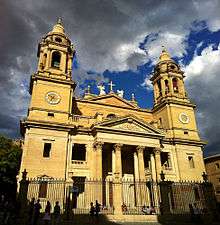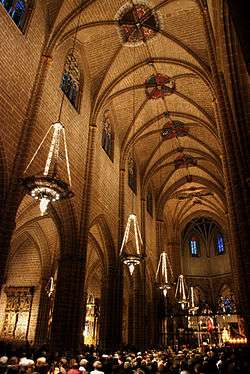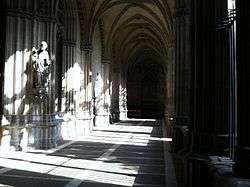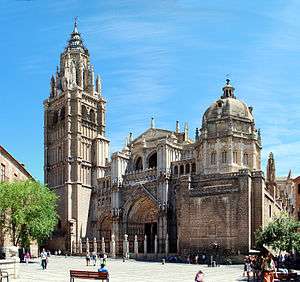Pamplona Cathedral
Pamplona Cathedral (Santa María la Real) is a Roman Catholic church in the archdiocese of Pamplona, Spain. The current 15th century Gothic church replaced an older Romanesque one. Archaeological excavations have revealed the existence of another two earlier churches. The Neoclassical façade was designed by Ventura Rodríguez in 1783. It has a 13th-14th-century Gothic cloister that provides access to two other Gothic rooms: the Barbazan chapel and the refectory. The Mediaeval kings of Navarre were crowned and some also buried there. The Navarrese Cortes (Parliament) was held there during the early modern ages.
| Cathedral of Saint Mary the Royal Catedral de Santa María la Real | |
|---|---|
 Pamplona Cathedral | |
| Religion | |
| Affiliation | Roman Catholic Church |
| District | Archdiocese of Pamplona y Tudela |
| Rite | Roman |
| Ecclesiastical or organizational status | Cathedral |
| Location | |
| Location | Pamplona, Spain |
| Geographic coordinates | 42°49′10.93″N 1°38′27.57″W |
| Architecture | |
| Type | Church |
| Style | Neoclassical, Gothic, Romanesque, Baroque, Renaissance |
The church

The site of the cathedral is the oldest part of the Roman Pompaelo. Archaeological excavations in 1994 have revealed streets and buildings from the 1st century BC. The oldest cathedral was demolished in 924 during the invasion of Abd-al-Rahman III, Caliph of Cordoba. During the reign of Sancho III (1004–1035) the church was reconstructed. That church was demolished from 1083 to 1097, and the Romanesque cathedral was built from 1100 to 1127. It collapsed in 1391, with only the façade remaining. The building of the current Gothic church began in 1394 and lasted to 1501. The floorplan is cruciform with ambulatory, a central nave and four shorter aisles, all covered by partially polycromed rib vault. The style is very influenced by French models.
The sculpture of the interior includes the sepulchre of Charles III of Navarre and spouse, by Jehan Lome de Tournai (1419), and the image of Royal Saint Mary, a Romanesque woodcarved silverplated sculpture. The choir, with its Renaissance choir stalls (1541), is separated from the nave by a Gothic iron grating (1517). There was a Renaissance retable (1598) in the presbytery, now in the church of Saint Michael in Pamplona. In the lateral chapels there are two Gothic retables (c.1500, 1507); one Italian Renaissance retable (16th century); one late Renaissance retable (1610, polycromed in 1617); and five Baroque retables (1642, 1683, 1685).
The cloister


Probably, the most outstanding element of the cathedral is its 13th century cloister. As the temple, the style followed the French Gothic architecture, and the sculptural decoration is very rich. The door that gives access from the temple shows the Dormition of the Virgin, and at the mullion stands a 15th-century sculpture of the Virgin Mary. The Barbazan chapel—named after the Pamplonese bishop buried there, Arnaldo de Barbazán—is covered by a Gothic eight-rib vault. The so-called 'Precious Door' gives access to the ancient canons' dormitory and shows a complete sculptural story of the Virgin Mary's life. There are several notable burials: Bishop Miguel Sánchez de Asiáin's (14th century), Viceroy of Navarre Count of Gages' (Baroque, 18th century) and guerrilla fighter Francisco Espoz y Mina's (Neo-classical, 19th century). The lavatory is closed by a grid whose iron is said to be from the battle of Navas de Tolosa. Another decorated Gothic door gives access to the old kitchen and the refectory.
Diocesan Museum
The former canons' rooms house the Diocesan Museum. The main room is a 14th-century rib-vault covered refectory. The adjacent kitchen is covered by a pyramidal stone-built chimney. This museum exhibits pieces of religious art from the cathedral and from many other Navarrese churches, many of them abandoned today: Romanesque, Gothic, Renaissance and Baroque sculpture, Gothic and Baroque painting, and 13th to 18th centuries goldsmith and silversmith.
The most outstanding silversmith pieces are the Gothic Holy Sepulcher reliquary, made in 13th century Paris; the 14th century Lignum Crucis reliquary and the Renaissance 16th century processional monstrance.
Bibliography
- Navallas, Arturo; Jusué, Carmen (eds.): La catedral de Pamplona (2 vols.), Pamplona: Caja de Ahorros de Navarra, 1994
- Arraiza, Jesús: Catedral de Pamplona: la otra historia, Pamplona: Ediciones y Libros, 1994
External links
| Wikimedia Commons has media related to Cathedral of Pamplona. |
- Cathedral of Pamplona's web page
- (in Spanish) Catálogo monumental de Navarra:
- The temple
- Façade
- Juan de Anchieta's Crucified Christ
- Choir stalls
- Main retable, now in the church of Saint Michael of Pamplona
- Charles III's sepulcher
- The 'Precious Door'
- Holy Sepulcher reliquary
- Processional monstrance
- The Art of medieval Spain, A.D. 500-1200, an exhibition catalog from The Metropolitan Museum of Art Libraries (fully available online as PDF), which contains material on Pamplona Cathedral (no. 96)
